必修五Unit1-3语法:过去分词的用法
人教版 高中英语 必修5 unit1 知识讲解 过去分词作表语和定语
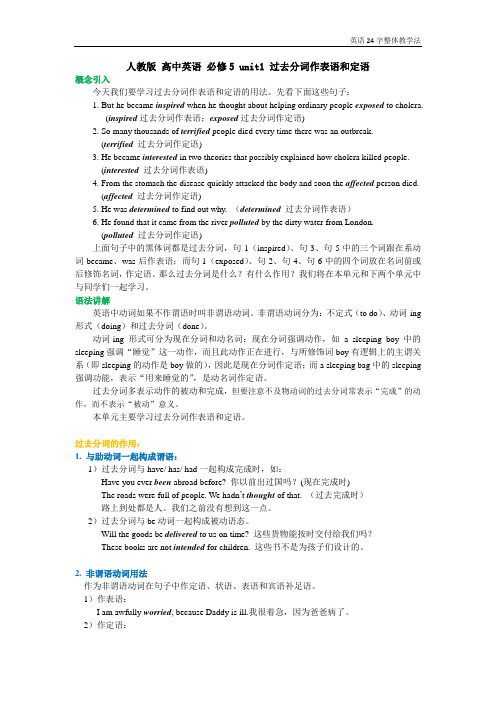
人教版高中英语必修5 unit1 过去分词作表语和定语概念引入今天我们要学习过去分词作表语和定语的用法。
先看下面这些句子:1. But he became inspired when he thought about helping ordinary people exposed to cholera.(inspired过去分词作表语;exposed过去分词作定语)2. So many thousands of terrified people died every time there was an outbreak.(terrified过去分词作定语)3. He became interested in two theories that possibly explained how cholera killed people.(interested 过去分词作表语)4. From the stomach the disease quickly attacked the body and soon the affected person died.(affected过去分词作定语)5. He was determined to find out why. (determined过去分词作表语)6. He found that it came from the river polluted by the dirty water from London.(polluted过去分词作定语)上面句子中的黑体词都是过去分词,句1(inspired)、句3、句5中的三个词跟在系动词became、was后作表语;而句1(exposed)、句2、句4、句6中的四个词放在名词前或后修饰名词,作定语。
那么过去分词是什么?有什么作用?我们将在本单元和下两个单元中与同学们一起学习。
语法讲解英语中动词如果不作谓语时叫非谓语动词。
必修5_unit1_过去分词作定语和表语(上课用)
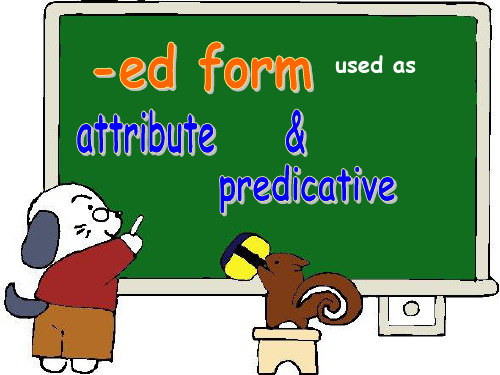
B. to be written
C. written
D. being written
was constructed in only 2 year.
练习二 单句改错
1. They were all amusing at what he said.
2. He was very exciting to hear the news that their team had won.
3. The situation was a bit discouraged.
depressing ~ depressed
Fill in the blank with proper words.
1. A. Nobody was interested in the story he told. B. The story he told was very interesting .
people addicted to drugs
a novel written by Luxun the advice given to the patient an old man supported by his son a school built for orphans
单个过去分词修饰 something, everything, anything, nothing,
( interested, interesting )
2. A. Everybody was excited to hear the news.
B. The news is very exciting indeed.
( excited, exciting ) 3. A. The result of the test was rather disappointing.
2018-2019学年高中英语人教版必修5Unit 1 Section Ⅲ Grammar——过去分词作定语和表语
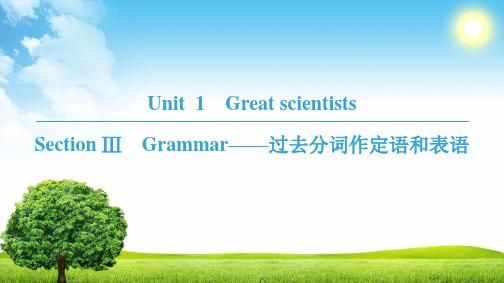
Section Ⅲ
Grammar——过去分词作定语和表语
[语 境 自 主 领 悟]
语 境 自 主 领 悟
先观察原句 1.From the stomach the disease quickly attacked the body and soon the affected person died. 2.So many thousands of terrified people died every time there was an outbreak. 3.He found that it came from the river polluted by the dirty water from London. 4.But he became inspired when he thought about helping ordinary people exposed to cholera.
返 首 页
语 境 自 主 领 悟
3.现在分词与过去分词作表语的区别 过去分词 现在分词 表示人自身的感受或事物自身的状态,常译作“感到……的” 表示事物具有的特性,常译作“令人……的”
语 法 应 用 落 实
They became so worried that they stayed awake all night.
返 首 页
语 法 精 要 点 拨
语 法 应 用 落 实
语 境 自 主 领 悟
2.过去分词作表语与被动语态的区别 过去分词作表语时,强调主语所处的状态,而动词的被动语态表示主语是动作 的承受者,强调动作。 The cup is broken.
语 法 应 用 落 实
语 法 精 要 点 拨
高二必修五1-3单元语法小结

高二英语必修5:过去分词语法总结与练习一、过去分词作定语1.单个过去分词作定语,常放在被修饰词的前面;过去分词短语作定语,常放在被修饰词的后面。
English is a widely used language.This is one of the schools built in 1980s.2.过去分词作定语时,可转换为一个定语从句。
注意两点:首先,在被替换的定语从句中,主语必须是作从句主语的关系代词;其次,定语从句中的谓语动词通常使用表示已经完成的时态或被动语态.He didn’t tu rn up at the meeting held yesterday.I found it hard to understand the English spoken by native villagers.3.辨析:过去分词做定语与其修饰词之间是动宾关系且过去分词表示的动作已完成;现在分词作定语表示动作正在发生,与修饰词是主谓关系;不定式作定语表示将要发生的动作。
The Olympic Games, ___ in 776 B.C. did not includewomen players until 1912.A. first playedB. to be first playedC. first playingD. to be first playingfirst played in 776B.C. = which was first played in 776 B.C.4. 如果被修饰的词是由every/some/any/no + thing/body/one所构成的复合代词或指示代词those等时,即使一个单一的分词作形容词用,也要放在被修饰词的后面。
例如:Is there anything unsolved? 还有没解决的问题吗?练习:1. Did you attend the meeting ______yesterday?A. to be heldB. having been heldC. heldD. being heldDo you know the name of the play___ in the hall now?A. to be put onB. being put onC. put onD. putting on3. I borrowed a book ______ by Mark Twain from the library last week. I like it very much..A. writtenB. writingC. was writtenD. to write4. Please don’t forget him. He is one of _______.A. those invitedB. invited thoseC. those invitingD. inviting those 答案:CBAA二、过去分词作表语1.用作表语的过去分词被动意味很弱,主要表示动作的完成和主语的状态,此时相当于一个形容词;在被动语态中的过去分词动词意味很强,句子主语为动作的承受者,后面常跟by短语。
必修五Unit 1 Section Ⅲ Grammar——过去分词作定语和表语
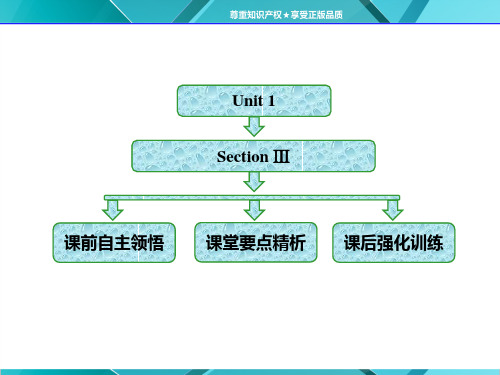
[即时演练 5] (1)用所给词的适当形式填空 ①(福建高考改编)In April, thousands of holidaymakers
stuck (stick) abroad due to the volcanic ash cloud. remained ______
②(四川高考改编) Ladies and gentlemen, please remain
[即时演练 3]
完成句子
①(陕西高考改编)刚才警察询问的目击者对这次打架给出了完 全不同的描述。
questioned by the police just now gave very The witnesses ________________________
different descriptions of the fight. ②(山东高考改编)除了一个书橱在墙角外,房间里空空荡荡。
This is the question discussed yesterday. 这是昨天讨论的问题。(表被动和完成) (2)不及物动词的过去分词作定语,它不表示被动意义,只 强调动作完成。 fallen leaves 落叶 the risen sun 升起的太阳
a retired teacher 一位退休教师
South Africa.
to be finished (finish) next year is sponsored ③The project ______________
(赞助) by his company.
to be completed (complete) ④(四川高考改编)The airport ________________
standing in one The room is empty except for a bookshelf __________________
人教课标版高中英语必修5 Unit1_单元语法详解
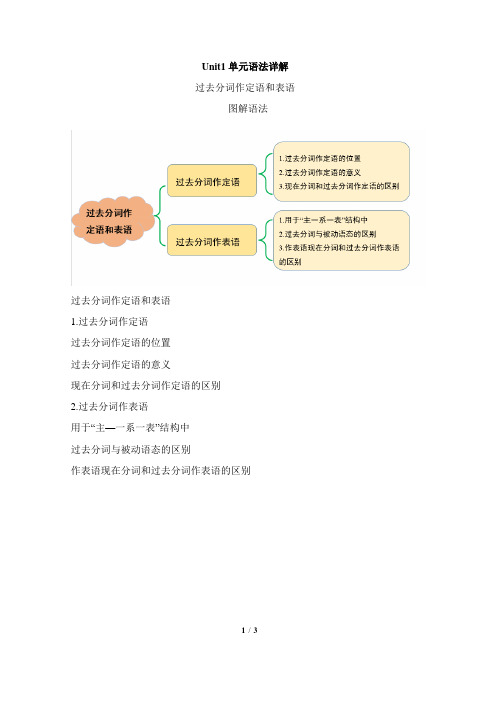
Unit1单元语法详解过去分词作定语和表语图解语法过去分词作定语和表语1.过去分词作定语过去分词作定语的位置过去分词作定语的意义现在分词和过去分词作定语的区别2.过去分词作表语用于“主—一系一表”结构中过去分词与被动语态的区别作表语现在分词和过去分词作表语的区别1/ 3归纳语法过去分词,也称动词的-ed形式,是一种非限定动词。
规则动词的-ed形式由动词原形词尾加-ed构成,也有不规则动词变化表。
动词的-ed形式只有一种形式,没有时态和语态的变化。
它在句子中可以充当定语、表语等成分。
一、过去分词作定语1.过去分词作定语时的意义过去分词作定语,强调被动或者完成。
The wind swept the fallen leaves.风刮走了落叶。
Her daughter brought up by me has begun to work.她由我带大的那个女儿已经开始工作了。
fallen leaves 落叶/falling leaves正在飘落的树叶2.过去分词作定语时的位置(1)单个的过去分词作定语,常放在所修饰的词的前面;过去分词短语作定语时,常放在所修饰的词之后,此时,它相当于定语从句。
He told me that this was the wounded soldier.他告诉我这就是那个受伤的士兵。
Don't use words, expressions or phrases known only to people with specific knowledge. 不要使用仅仅有特定知识的人才知晓的单词、词组或短语。
Near the window is a bookshelf filled with books (=which is filled with books).靠近窗户有一个装满书的书架。
2/ 3Most of the students invited to the garden party (=who were invited to the garden party)came from our school.大部分被邀请参加游园会的学生来自我们学校。
必修5unit3语法过去分词作状语PPT课件

Combine the two sentences
our future school
1.When our future school is seen from the space, our future school looks like a plate. Seen from the space, our future school looks like a plate.
3. Past Participle can be used as object complement
She had her hair cut (cut) The old man saw his bike repaired
(repair) by a policeman. The thief came out with his hands tied
1. Past Participle can be used as attribute
The ground is covered by fallen (fall) leaves.
Who were the guests invited (invite) to Tom’s concert last month?
Deeply moved (move) by liyang’s speech, he shed (流下) tears.
Please find out the past participles.
1.The s_t_o__le__n_bike belongs to Jack.1.作定语
过 2.The glass is b_r_o__k_e_n_ .
4. Past Participle can be used as adverbial
人教版高二英语必修五第一单元语法——过去分词

Further information:
Difference between the Present Participle and the Past participle
1 Choose appropriate verbs to complete
the following sentences, using the past participle. Explain the use of the past participle in each sentence. (P43)
-- I hear you and James are engaged at last. -- Yes, we are. -- When are you getting married? -- In the spring. -- Oh, lovely. Where’s the wedding going to be?
6. children who are astonished at/by … 7. a vase that is broken 8. a door that is closed 9. the audience who are tired of … 10. an animal that is trapped in/by …
to take the victims to safe areas from
the flood.
5. Most of the newspaper seems to be
_________ concerned with pop stars.
用来修饰人的过去分词有时可以转移
到修饰非人的事物,变成所谓的转移
形容语。这种过去分词在形式上直接 修饰人,但它所修饰的事物仍与人直 接有关。 The general stared at him in startled admiration. 将军以惊讶而赞赏的眼光注视着他。
必修五Unit 1 过去分词作定语和表语
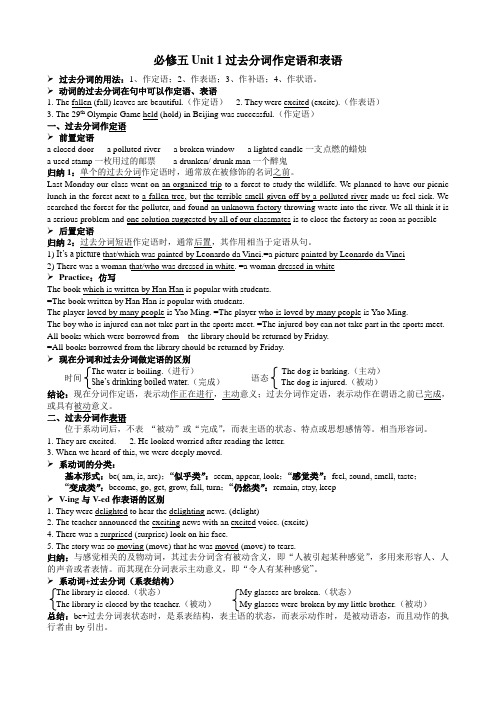
必修五Unit 1过去分词作定语和表语过去分词的用法:1、作定语;2、作表语;3、作补语;4、作状语。
动词的过去分词在句中可以作定语、表语1. The fallen (fall) leaves are beautiful.(作定语)2. They were excited (excite).(作表语)3. The 29th Olympic Game held (hold) in Beijing was successful.(作定语)一、过去分词作定语前置定语a closed door a polluted river a broken window a lighted candle一支点燃的蜡烛a used stamp一枚用过的邮票 a drunken/ drunk man一个醉鬼归纳1:单个的过去分词作定语时,通常放在被修饰的名词之前。
Last Monday our class went on an organized trip to a forest to study the wildlife. We planned to have our picnic lunch in the forest next to a fallen tree, but the terrible smell given off by a polluted river made us feel sick. We searched the forest for the polluter, and found an unknown factory throwing waste into the river. We all think it is a serious problem and one solution suggested by all of our classmates is to close the factory as soon as possible后置定语归纳2:过去分词短语作定语时,通常后置,其作用相当于定语从句。
必修五_unit1Grammar 过去分词用法

• 3我对昨晚看的电影很失望,我原以为它能好些。
(disappointed) • I _w_a_s__d_i_sa__p_p_o_i_n_t_e_d_w__i_th_ the film I saw last night, I
had expected it to be better.
d__is_a_p__p_o_i_n_t_e_d(disappoint) to see it,but
they still wished him a happy life.
•Practice: Complete the sentences using the past participle as the predicative.
Grammar 过去分词V-ed的
用法
1.作定语
过 去
2.作表语
分 词3.作补语源自4.作状语V-ed (动词的过去分词),在句中可以作定语、 表语。
The__fa_l_le_n_ (fall) 定语
leaves are beautiful.
They were e_x_c_i_t_e_d__表
(excite).
语态
The dog is barking. The injured dog is sad.
结论:
区别
现在分词作定语,表示动作_正__在__进__行___,
___主__动__意义;
过去分词作定语,表示动作在谓语之前
已__完__成___,或具有__被__动____意义.
不及物动词的过去分词作定语,只表
一枚用过的邮票
a used stamp
一个醉鬼
a drunken/ drunk man
人教版高中英语必修5unit1知识讲解过去分词作表语和定语
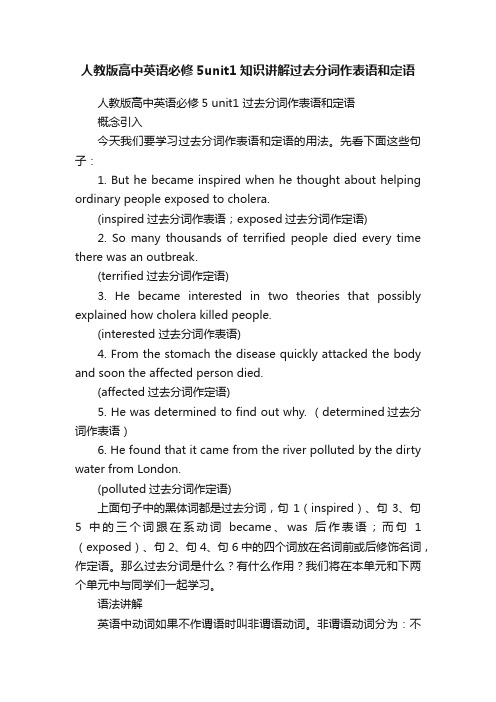
人教版高中英语必修5unit1知识讲解过去分词作表语和定语人教版高中英语必修5 unit1 过去分词作表语和定语概念引入今天我们要学习过去分词作表语和定语的用法。
先看下面这些句子:1. But he became inspired when he thought about helping ordinary people exposed to cholera.(inspired过去分词作表语;exposed过去分词作定语)2. So many thousands of terrified people died every time there was an outbreak.(terrified过去分词作定语)3. He became interested in two theories that possibly explained how cholera killed people.(interested 过去分词作表语)4. From the stomach the disease quickly attacked the body and soon the affected person died.(affected过去分词作定语)5. He was determined to find out why. (determined过去分词作表语)6. He found that it came from the river polluted by the dirty water from London.(polluted过去分词作定语)上面句子中的黑体词都是过去分词,句1(inspired)、句3、句5中的三个词跟在系动词became、was后作表语;而句1(exposed)、句2、句4、句6中的四个词放在名词前或后修饰名词,作定语。
那么过去分词是什么?有什么作用?我们将在本单元和下两个单元中与同学们一起学习。
高中英语人教版必修五 Unit3 Grammar动词过去分词作状语

Past participle (3) used as Adverbial 过去分词作状语
过去分词
过去分词是非谓语动词的一种形 式,表示完成和被动的动作。它在句子 中可以充当状语、定语等成分。
过去分词表完成或被动, 作状语时, 其逻辑主语是主句的主语, 且与主语 之间存在着被动关系。过去分词作 状语可表时间, 原因, 让步, 方式, 伴 随,条件等。
=Even if / Though it is explained a hundred times, the problem still can't be understood.
过去分词作让步状语
归纳: 过去分词作让步状语,相当于一个 由though, although 或 even if / though等引导的让步状语从句。
= The teacher stood there and he was surrounded by the students.
过去分词作方式或伴随状语
归纳: 过去分词作方式或伴随状语,若有 连词 as if, 就转换为 as if 引导的方 式状语从句;若无连词,则转换为 并列结构。
随堂练习 1. 句型转换:
4. Given more time, we would be able to do the work much better. If we were given more time, we would be able to do the work much better.
5. Once translated into Chinese, the book became very popular among Chinese teenagers. Once it was translated into Chinese, the book became very popular among Chinese teenagers.
(完整版)人教版高中英语必修五Unit1知识点详解

必修5 Unit1 Great scientistsPart 1. Warming up1.explain及物动词(vt.)解释;说明;阐明[(+to)][+wh-][+(that)]He explained that he had been cheated. 他解释说他是上当受骗了。
Can you explain how the machine operates?你能解释一下这机器是如何运转的吗?Please explain this rule to me.请给我讲解一下这条规则。
不及物动词(vi.)解释;说明;辩解I've got to explain about it. 我得解释一下此事。
2.characteristicn. 特征;特性Kindness is one of his characteristics.adj. 独特的I heard my friend’s characteristic laugh.be characteristic of sb./sth. 是.....的特性Such bluntness is characteristic of hin. 如此迟钝是他的特性。
3. Who put forward a theory about black holes?put forward 提出(建议等);提名;提前,把时钟往前拨He put forward a new plan. 他提出一个新计划。
May I put your name forward as a possible chairman of the committee?我能否提名你当委员会主席?[归纳拓展]put down 记下;镇压put out 关掉;熄灭put aside 放在一边;储存;保留put off 推迟;延期put up 建造;举起;张贴put on 穿上put away 收好选词填空(put off, put up, put forward, put aside, put out)①The plan that you _____ at the meeting is wonderful.②Many tall buildings were _____ along the road.③Firefighters have been called to _____ the fire in the city center.④He has a little money to _____ for a rainy day.⑤Don’t _____ until tomorrow what can be done today.Part 2. Pre-reading, reading and comprehending1. Do you know how to prove a new idea in scientific researchhow to prove a new idea 为“疑问词+不定式”结构,该结构可在句中作主语、宾语、表语等。
人教版高二英语必修5过去分词语法课件讲解

❖ boiled water = water which has boiled
❖ fallen leaves = the leaves which have fallen
= There are many leaves which had on the ground. (地上有许多落叶)
Some of them, born and brought up in rural villages, had never been to Beijing. = Some of them , who had been born and brought up in rural villages, had never been to Beijing.
Past Participle as the Predicative
1. 2. 3. 4. 5. 6. children who look astonished
7. a vase that is broken 8. a door that is closed 9. the audience who feel tired 10. an animal that is trapped
6. Astonished children 7.a broken vase 8.a closed door 9.the tired audience 10.a trapped animal
1.people who are terrified 2.seats that are reserved 3.water that is polluted 4.a room that is crowded 5.a winner that is pleased
人教版高二英语必修5过去分词语法讲解(课堂PPT)
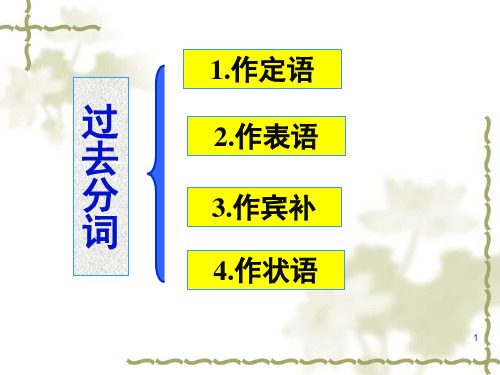
过 去
2.作表语
分 词
3.作宾补
4.作状语
1
The Past Participle used as
Attribute
2
过去分词作定语
. 教学目标 1、过去分词作定语的意义
. 2、过去分词作定语的位置
3、过去分词作定语与现在分词作定语的 区别
.
3
过去分词作定语
过去分词作定语的基本用法 1.过去分词作定语的意义
反展中国家
developed countries
发达国家
falling leaves
落叶(正在进行)
fallen leaves
落叶(已经完成) 12
The child standing over there is my brother.
The room facing south is our classroom. The book written by Lu Xun is very good. The road completed yesterday is leading
The water
___________________________(送到她家
的水) carried disease.
16
The English today is quite different from the
English __________________的位置
(1)单个的过去分词作定语一般放在被 修饰的名词之前,但left 、given只作后 置定语
1.The broken vase has been thrown outside. 2.The wounded soldier was looked after
必修五 过去分词用法总结
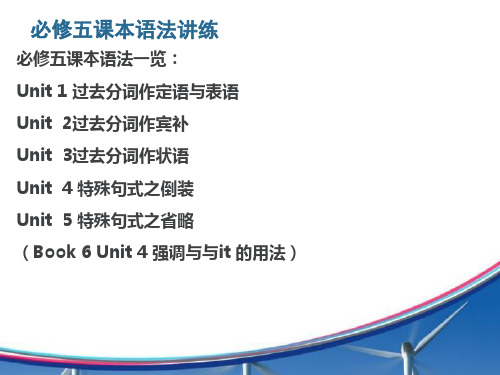
boiled water
fallen trees/ leaves escaped animals
比较
boiling water
falling leaves
比较
an escaping criminal
the rising sun
the risen sun
The broken window made the house very ugly.
She walked out of the house, followed by her little daughter. She walked out of the house, and she was followed by her little daughter.
e、表示让步 Beaten by the enemy, he refused to let out the secret. Although he was beaten by the enemy, he refused to let out the secret.
作宾补
1.表“希望,要求”的动词: want, wish, expect, wish, like, order + (to be) done I want the work (to be) finished by Sunday. Jim ordered the room (to be) cleaned. 2.表“感觉,心理状态”的动词: see, hear, feel, watch, notice, find, think + object + p.p. We saw the thief caught by the police. People found the water polluted.
高考英语必修五讲义Unit1SectionⅢGrammar—_过去分词作定语和表语
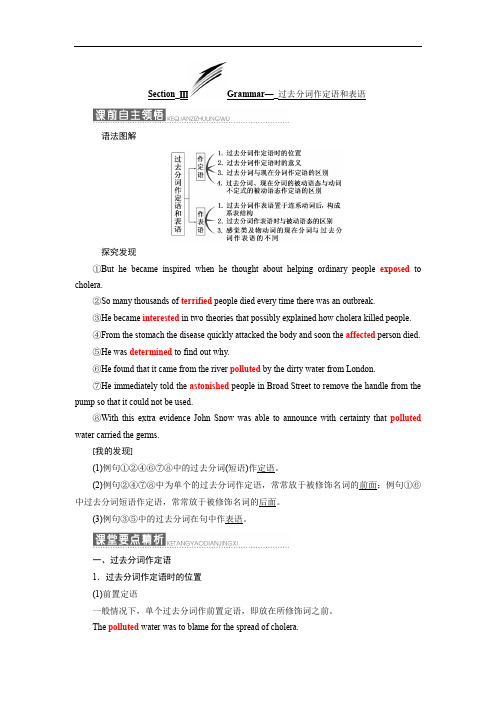
Section_ⅢGrammar—_过去分词作定语和表语语法图解探究发现①But he became inspired when he thought about helping ordinary people exposed to cholera.②So many thousands of terrified people died every time there was an outbreak.③He became interested in two theories that possibly explained how cholera killed people.④From the stomach the disease quickly attacked the body and soon the affected person died.⑤He was determined to find out why.⑥He found that it came from the river polluted by the dirty water from London.⑦He immediately told the astonished people in Broad Street to remove the handle from the pump so that it could not be used.⑧With this extra evidence John Snow was able to announce with certainty that polluted water carried the germs.[我的发现](1)例句①②④⑥⑦⑧中的过去分词(短语)作定语。
(2)例句②④⑦⑧中为单个的过去分词作定语,常常放于被修饰名词的前面;例句①⑥中过去分词短语作定语,常常放于被修饰名词的后面。
- 1、下载文档前请自行甄别文档内容的完整性,平台不提供额外的编辑、内容补充、找答案等附加服务。
- 2、"仅部分预览"的文档,不可在线预览部分如存在完整性等问题,可反馈申请退款(可完整预览的文档不适用该条件!)。
- 3、如文档侵犯您的权益,请联系客服反馈,我们会尽快为您处理(人工客服工作时间:9:00-18:30)。
closed The boy sleeps with the door________. (close) closing I saw the boy _______ the door. (close)
宾语the boy, 与close主谓关系,宾补用现在分词。
宾语the door,与close构成动宾关系,用过去分词做宾补。
1. 分词做定语
closing The boy _________ the door is my brother.( close)
被修饰词the boy, 与close构成主谓关系,用现在分词。 I like the book ________ in English. (write) written 被修饰词the book, 与write构成动宾关系,用过去分词。 2. 分词做宾语补足语
4.作状语(说明事情发生的时间、 地点、条件、原因、方式、伴随动 作等情况)
1.过去分词作定语
• Most of the people invited to the party were famous scientists. • If I had the chance, I would have a cloned baby. • the fallen leaves 落下的叶子 =the leaves that have fallen. • the completed building 竣工的楼房 =the building that was completed.
Usage:
1.作定语(在名词或代词前后,一般 情况下,单个在前,短语在后)
过 去 分 词
2.作表语(在be或联系动词之后,如 become; get; go; seem; remain; keep; look; feel; sound等) 3.作宾补(主+谓+宾+宾补,补充说 明宾语的性质或所处的状态)
Consolidation
1. What’s the language _______ in New Zealand? A. speaking B. spoken C. be spoken D. to speak 2. The car _______ in Germany in the 1960s looks old. A. produced B. producing C. to produce D. which produced 3. You’d better have your sports jacket _____. It’s dirty. A. to wash B. washed C. washing D. wash 4. Yesterday I heard a story _______ by my friend. A. told B. telling C. to tell D. tell 5. Generally speaking, when _____according to the directions, the drug has no side effect. A. taking B. taken C. to take D. to be taken
6. The first textbooks __ for teaching English as a foreign language came out in the 16th century. A. having been written B. to be written C. being written D. written 7. Is this the watch you wish _____? A. to have repaired B. to repair it C. to have it repaired D. will be repaired 8. _____ many times, but he still couldn't understand it. A. Having been told B. Though he had been told C. He was told D. Having told 9. As is known to us all, traveling is _____, but we often feel _____ when we are back from travels. A. interesting; tired B. interested; tiring C. interesting; tiring D. interested; tired
3. 分词做状语 ________ in English, the book is well-received Written throughout the world. (write) 主语the book, 与write构成动宾关系, 用过去分词做状语 enjoying He walked in the forest _________ the beautiful scenery along. (enjoy) 主语he, 与enjoy 构成主谓关系,用现在分词做状语
• 分词作状语时,无论主动还是被动形式,分词动作的逻 辑主语和主句的主语应该保持一致
• 当v-ing形式作状语时,要考虑时态与语态若它所表 示的动作发生在谓语动作之前,需用having done, 如果表被动则用having been done
EXERCISES
1.I like reading the novels ________(write ) by Zhang Ailing. written writing 2. The girl ________(write) a letter in the study is my cousin. 3.There is something wrong with my car and I have to get it repaired _________(repair). 4.He spoke loudly in order to make himself ________(hear). heard crying 5. I found the little girl ________(cry) at the corner. painted 6. I want the doors of my new house _________(paint) white. surprised 7.There was a ___________ (surprise) look on his face. excited 8. He was ________ (excite) at the good news. moved 9. The story was so__________(move) that he was _______ moving (move) to tears. Following 10. ___________the old man, we went upstairs. (follow) Followed __________by the old man, we went upstairs.
单个分词作定语时,放在所修饰词之前;分词短语则放在之后。 多数情况下,及物动词的过去分词可以表示完成和被动含义;不 及物的过去分词则表示完成。过去分词作定语,可转换为相应 的含有被动语态的定语从句。
2.过去分词作ery much _____ in the job,but I’m not A sure whether he can manage it. A. interested B. interesting • 2.He seems quite delighted at the news. • 3.The glass is broken.(系表结构)
让步状语
方式状语
考点:分词的运用
现在分词V-ing表示主动和进行; 过去分词V-ed表示被动和完成;
做定语,判断它与被修饰词的关系, 主谓用 V-ing, 动宾用 V-ed. 做宾补,判断它与宾语的关系, 主谓用 V-ing, 动宾用 V-ed 做状语, 判断它与主语的关系, 主谓用 V-ing, 动宾用 V-ed.
过去分词作表语,多表示主语所处的状态,有被动意味,相当 于一个形容词。常用来作表语的过去分词有:interested, excited, impressed, disappointed, bored, delighted, discouraged, drunk, amused, astonished, tired, surprised, pleased, satisfied, worried, married, frustrated, frightened, scared等.
Grammar and usage
过去分词用法小集合
Features:
Past Participle
1.只有一种形式(规则+ed;不规则要记)
过 去 分 词
2.表被动或完成,或两种意义兼有。 3.有动词(被动语态中使用)、形容 词和副词的性质,故可用作定语、 表语、补足语和状语。 4.要区别现在分词(V-ing)和 动词不定式(to do)的用法。
链接高考
1.The managers discussed the plan that they would like to see _______the next year. (2000全国) A.carry out B.carrying out C.carried out D.to carry out 2. ________ the general state of his health, it may take him a while to recover from the operation. A. Given B. To give C. Giving D. Having given 3. It shames me to say it, but I told a lie when___ at the meeting by my boss. (04全国IV) A. questioning B. have questioned C. questioned D. to be questioned 4. You should understand the traffic rule by now. You‘ve had it____ often enough. (05天津) A. explaining B. to explain C. explain D. explained
